Ancient royal jewels served both decorative and symbolic purposes across civilizations. You’ll find Egyptian pharaohs adorned with divine gold pieces connecting them to Ra, while Chinese emperors prized jade as symbols of virtue and immortality. Mesopotamian rulers wore lapis lazuli to proclaim celestial authority, and Persian kings displayed gemstones worth millions in today’s currency. These exquisite treasures didn’t just beautify monarchs—they legitimized power, facilitated diplomacy, and guaranteed protection beyond death.
The Divine Adornments of Egyptian Pharaohs
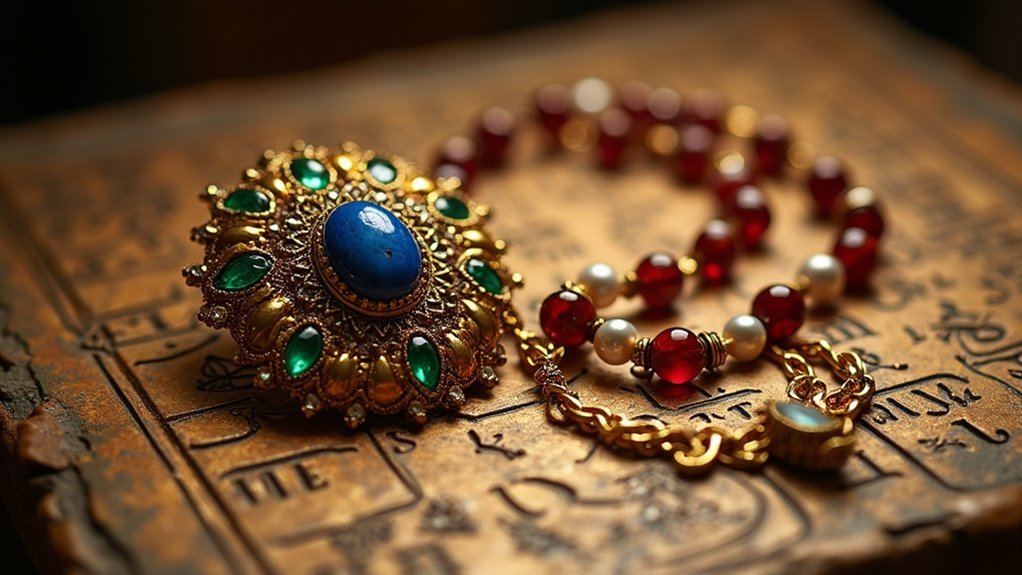
While modern royalty may impress with their crown jewels, ancient Egyptian pharaohs elevated royal adornment to an art form deeply intertwined with religious significance and afterlife preparation.
You’ll find this divine connection most evident in Tutankhamun’s tomb, where spectacular gold artifacts revealed pharaohs’ belief that their jewelry guaranteed protection beyond death.
These royal adornments weren’t merely decorative. Each piece served as a spiritual tool, with gold symbolizing their connection to Ra, the sun god.
Pharaohs adorned themselves with elaborate necklaces and bracelets featuring ankhs and scarabs, representing eternal life and resurrection.
Even Cleopatra understood jewelry’s dual purpose, wearing her pearls and emeralds not just as beautiful adornments but as strategic diplomatic instruments, enhancing her political influence with Rome through these dazzling divine symbols.
Mesopotamian Royal Treasures: Symbols of Celestial Authority
How did ancient Mesopotamian rulers establish their divine authority? They adorned themselves with spectacular jewelry crafted from gold and lapis lazuli, featuring intricate designs of stars and moons that proclaimed their celestial authority.
You’ll find these symbolic connections throughout their culture—from the elaborate Ishtar Gate with its glazed celestial imagery to the lavish treasures discovered in royal burials at Ur.
These weren’t merely decorative pieces; each diadem and beaded necklace reinforced the divine right to rule. When Sumerian, Akkadian, Babylonian, and Assyrian monarchs wore these prestigious items, they visibly connected themselves to the gods.
The jewelry served dual purposes—enhancing royal status among the living and accompanying rulers into the afterlife, where they’d continue their divine relationship.
The Jade Legacy of Chinese Imperial Dynasties
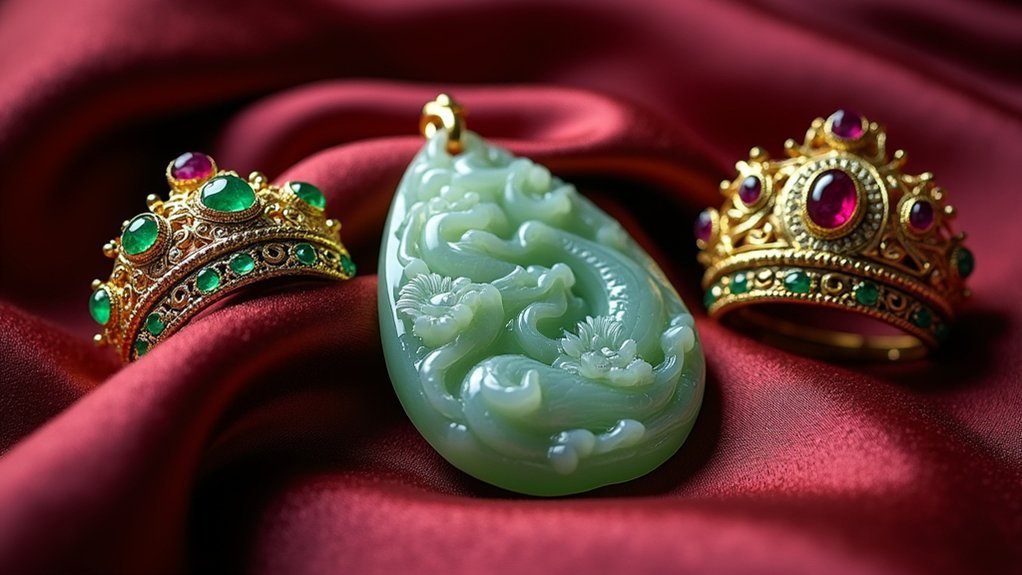
Unlike their Mesopotamian counterparts who favored celestial symbolism, Chinese emperors established their divine mandate through jade—a stone so culturally significant that it transcended mere adornment to become the embodiment of virtue itself.
Jade in Chinese imperial culture embodied divine favor—a physical manifestation of heaven’s blessing upon the ruler’s virtue.
You’ll find jade’s imperial connection stretching across dynasties, with the Qing period marking the zenith of jade craftsmanship.
- Han Dynasty (206 BC-220 AD) – Introduced jade burial suits believed to protect royalty in the afterlife
- Imperial Regalia – Jade scepters and seals conveyed authority and legitimacy to the ruler
- Craftsmanship Peak – Qing emperors commissioned masterpieces like the Jadeite Cabbage
- Cultural Continuity – The stone’s association with longevity and moral integrity persists in contemporary Chinese society
Mughal Emperors and Their Opulent Gemstone Collections
As the Mughal Empire rose to power across the Indian subcontinent in the 16th century, its rulers established what would become one of history’s most legendary treasure collections.
You’ll find that Mughal emperors prized gemstones not merely for their beauty but for their provenance and rarity, accumulating exquisite jewels from India’s rich natural sources like Golconda diamonds and Kashmir sapphires.
The ornate creations that adorned these rulers—such as the Patiala Ruby Choker and elaborate jighas (turban ornaments)—symbolized royal status and power.
European influences enhanced traditional craftsmanship through techniques like enamelling and advanced gem-cutting.
This magnificent legacy continues today, with prestigious houses like Cartier drawing inspiration from Mughal designs, proving the enduring influence of these imperial collections on modern jewelry artistry.
Byzantine Crowns: Where East Meets West
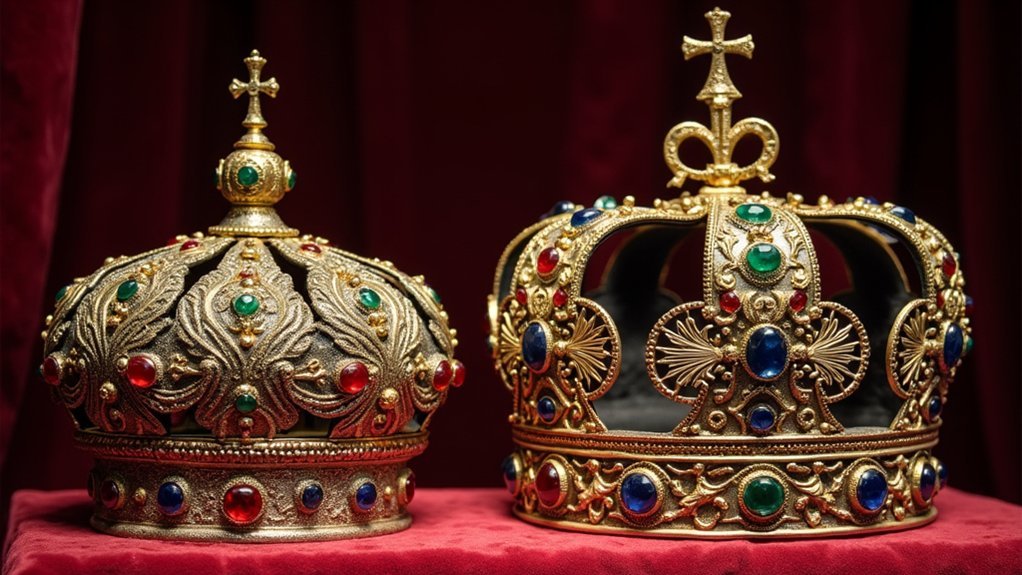
While the Mughal rulers dazzled the East with their gemstone treasures, the Byzantine Empire was crafting its own legendary royal regalia thousands of miles away.
You’ll find Byzantine crowns standing as magnificent symbols where imperial power met divine authority through elaborate craftsmanship.
These crowns weren’t merely decorative—they told stories of cultural exchange between Eastern and Western traditions, especially in the Crown of the Holy Roman Emperor.
- Gold and precious gemstones signified the emperor’s divine appointment
- Religious iconography connected imperial rule directly to church authority
- Intricate designs showcased the empire’s artistic achievements from the 4th-15th centuries
- The craftsmanship established techniques that influenced European royal regalia for centuries afterward
Medieval European Royalty and Sacred Jewel Traditions
You’ll find Medieval European royalty wore gold crosses and protective amulets as physical manifestations of their spiritual devotion and divine authority.
Charlemagne’s Crown, with its sapphires and emeralds, stands as the quintessential example of how jewels cemented the sacred nature of imperial power.
These royal treasures weren’t merely decorative but served as political instruments, with heraldic jewellery displaying family honor and gemstones from the Crusades enhancing the mystique of Europe’s ruling class.
Sacred Amulets’ Power
Faith intertwined with governance during medieval Europe, where royal jewels transcended mere adornment to become vessels of divine protection.
You’d find sacred amulets exchanged between royal families and the Church, strengthening political alliances while demonstrating devotion. Charlemagne’s Crown, with its dazzling gemstones, wasn’t just beautiful—it manifested imperial power and divine authority.
These powerful talismans served royalty in four distinct ways:
- Protected wearers from evil forces and misfortune
- Legitimized rulers through visual connection to heavenly power
- Cemented diplomatic relationships through spiritual gift exchanges
- Displayed family lineage through heraldic jewellery with sacred symbols
The Crusades further transformed these traditions as knights returned with exotic gems and Middle Eastern designs, enriching Europe’s sacred jewellery practices.
Crown Jewels’ Legacy
Medieval Europe’s most sacred treasures, the crown jewels, established enduring legacies that echo through centuries of royal tradition. You’ll find these weren’t merely decorative items but sacred objects believed to connect royalty with divine authority.
| Royal Collection | Significance | Legacy Impact |
|---|---|---|
| Charlemagne’s Crown | Symbol of holy authority | Unified church and state power |
| Heraldic Jewels | Displayed family lineage | Cemented political alliances |
| Crusader Acquisitions | Eastern gemstone integration | Revolutionized European craftsmanship |
| Church Exchanges | Religious endorsement | Legitimized royal authority |
When medieval monarchs wore these precious gemstones during significant events like coronations, they weren’t simply displaying wealth—they were invoking divine protection. The exchange of crown jewels between royal houses strengthened diplomatic ties, creating a complex network of power relationships that shaped medieval governance for centuries.
The Mesoamerican Elite: Gold and Jade as Divine Power
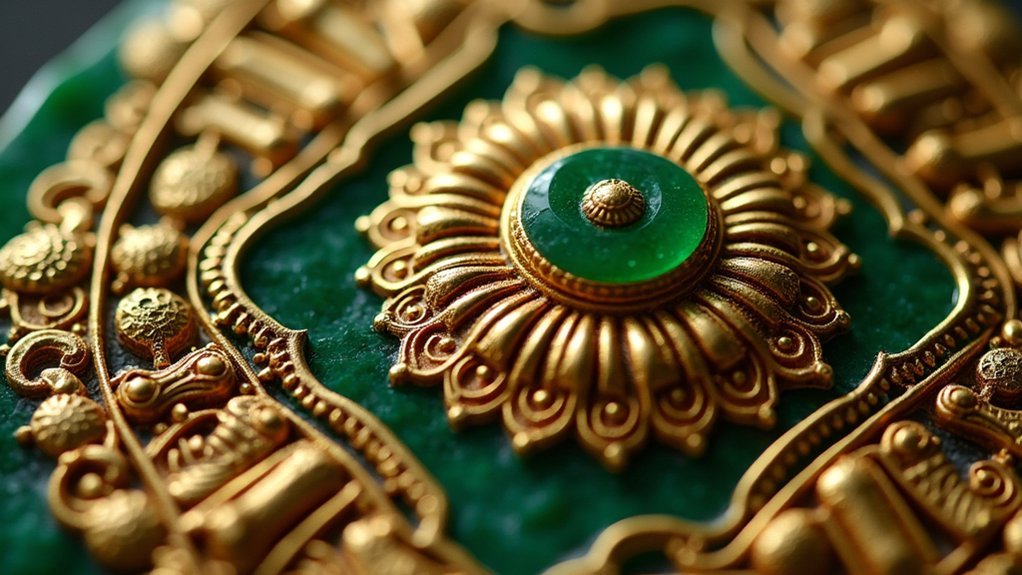
In the sun-drenched temples and royal courts of ancient Mesoamerica, gold and jade transcended mere decorative materials to become powerful conduits of divine authority.
You’d recognize the elite by their exquisite adornments, where skilled craftsmanship transformed these precious materials into symbols of their connection to deities.
When you examine Moctezuma II’s collection of artifacts, you’ll discover how these civilizations expressed their cosmological beliefs through precious materials:
- Gold pieces represented the sun’s divine energy, legitimizing rulers’ authority
- Jade artifacts symbolized life, fertility, and immortality for the wearer
- Ceremonial masks merged both materials to transform elites into godly beings
- Burial offerings protected nobility in their journey to the afterlife
Persian Royal Regalia: Symbols of the Immortal Empire
When you gaze upon the Persian Crown Jewels, you’re witnessing not just dazzling wealth, but the embodiment of an empire that considered itself immortal. These treasures showcased Persian opulence through exquisite craftsmanship and rare gems.
| Regalia Item | Notable Features | Historical Significance |
|---|---|---|
| Imperial Crown | Adorned with Koh-i-Noor diamond | Symbol of absolute authority |
| Peacock Throne | Encrusted with precious gems | Cost equivalent to $100M today |
| Daria-i-Noor | 182-carat pink diamond | One of world’s largest diamonds |
The jewels went beyond mere decoration—they served as diplomatic tools. Shah Abbas I’s jeweled sword exemplified this dual purpose as both weapon and artwork. You’ll find that Persian regalia’s influence extended far beyond aesthetics, representing the empire’s cultural achievements and global power through strategic displays of unmatched splendor.
Ancient Greek and Macedonian Royal Jewelry Craftsmanship
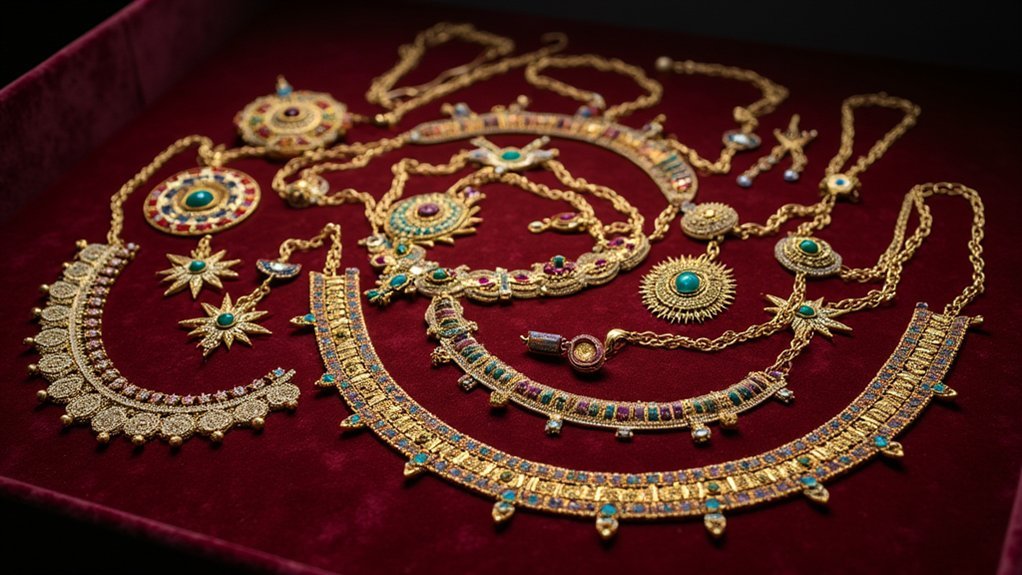
When you examine Greek royal jewelry, you’ll notice the remarkable goldwork techniques like granulation and filigree that created intricate diadems and ceremonial pieces.
Alexander the Great’s famed gemstone collection featured amethysts and emeralds that symbolized his divine status and far-reaching conquests.
The Macedonian burial treasures, particularly from Philip II’s tomb, reveal golden wreaths and decorated larnaxes that showcase the pinnacle of ancient metalworking artistry.
Greek Goldwork Techniques
Four remarkable techniques defined ancient Greek and Macedonian royal jewelry craftsmanship, establishing standards that craftsmen still admire today.
When you examine royal artifacts, you’ll notice the extraordinary goldwork demonstrating unparalleled mastery of intricate designs.
- Granulation – Tiny gold beads fused onto surfaces created textured patterns, adding dimension to otherwise flat jewelry pieces.
- Lost-wax casting – Enabled the production of complex three-dimensional forms with precise details that signified elite status.
- Filigree work – Artisans twisted fine gold wires into delicate ornamental designs, making lightweight yet visually stunning pieces.
- Gemstone setting – Precious stones adorned elaborate gold diadems and crowns, symbolizing divine authority and royal power.
These techniques produced jewelry so exquisite that centuries later, these masterpieces still showcase the rich cultural heritage of ancient craftsmen.
Alexander’s Gemstone Collection
While Greek goldsmiths perfected their techniques, Alexander the Great assembled what historians consider one of the ancient world’s most spectacular gemstone collections.
You’ll find his treasury included exquisite jewelry from across his conquered territories, featuring intricate designs with gold, silver, emeralds, sapphires, and pearls.
The famous “Alexander’s Ring,” a gold signet ring bearing Hermes’ portrait, exemplifies the perfect fusion of artistry and symbolism in Macedonian royal adornments.
Beyond displaying wealth, these gemstones carried profound cultural meanings—many believed they possessed protective and healing properties.
After Alexander’s death in 323 BCE, his generals divided his treasures, spreading Hellenistic jewelry styles throughout the Mediterranean world.
This distribution of wealth catalyzed new artistic traditions that would influence royal jewelry design for centuries to come.
Macedonian Burial Treasures
Beneath the soil of ancient Aigai lie some of history’s most spectacular jewelry treasures, offering unparalleled insights into Macedonian royal opulence.
When you examine the tomb of Philip II, you’ll discover ornate gold jewelry that showcases extraordinary craftsmanship—from delicate filigree work to intricate granulation techniques. These royal jewels weren’t merely decorative; they represented status and provided spiritual protection in the afterlife.
- Gold masks served as eternal faces for the deceased, preserving their identity for eternity.
- Elaborate fibulae (brooches) demonstrated the wearer’s social standing even in death.
- Diadems and wreaths mimicked natural forms, connecting royalty to divine powers.
- Gemstone inlays revealed sophisticated metallurgy knowledge, combining beauty with technical mastery.
These funerary practices reflect how Macedonians viewed jewelry as both art and spiritual necessity.
Frequently Asked Questions
What Are the Oldest Royal Jewels in the World?
You’ll find the Koh-i-Noor diamond among the oldest royal jewels, dating back to ancient India. Other contenders include England’s Crown Jewels with medieval origins and Russia’s Imperial Crown from 1762.
What Is the Rarest Piece of the Queen’s Crown?
The Koh-i-Noor Diamond is your answer—it’s the rarest piece in the Queen’s Crown. At 105.6 carats, this “Mountain of Light” carries a controversial history and is claimed by multiple countries.
What Is the Controversial Jewel in the Crown?
You’ll find the Koh-i-Noor Diamond is the most controversial jewel in the crown. It’s claimed by multiple countries including India and Pakistan, who’ve called for its return since Britain seized it in 1849.
What Is the Most Valuable Crown Jewelry in the World?
You’ll find the UK’s Crown Jewels are considered the most valuable collection worldwide, worth over £3 billion. The Imperial State Crown alone contains nearly 3,000 diamonds including the massive Cullinan II diamond.
In Summary
Throughout history, you’ve witnessed how royal jewels transcend mere decoration. They’re portals into ancient societies, revealing power structures, trade networks, and spiritual beliefs. You’ll find that despite diverse cultural expressions, these treasures consistently represented divine authority and cosmic order. As you’ve explored these glittering legacies, you’ve uncovered not just material wealth, but the timeless human desire to capture eternity through exquisite artistry.

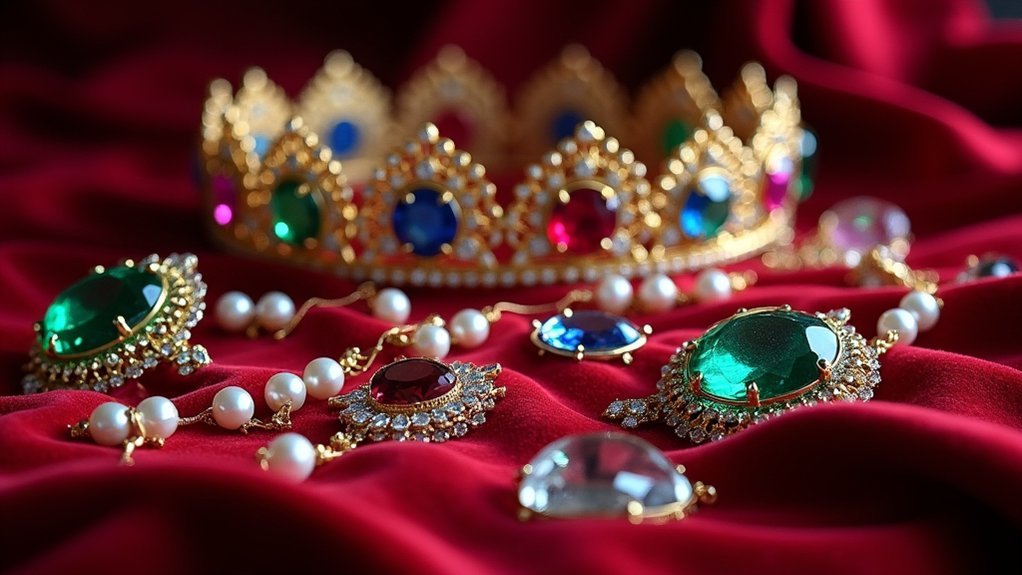



Leave a Reply